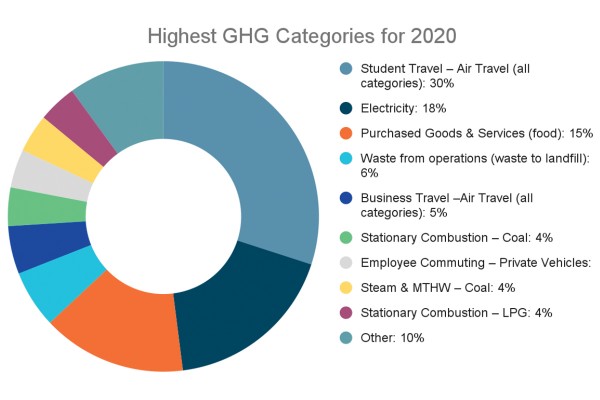A new report has found the Uni’s carbon emissions dipped by 40% in 2020, to 30,661 tonnes of carbon dioxide equivalent (tCO2e). Reasons for the decrease include a lockdown, fewer jet-setting employees and a coal phaseout.
The Uni’s latest Greenhouse Gas Inventory was released in February 2022. The report encompasses emissions from all of Otago’s campuses (in Dunedin, Christchurch, Wellington and Invercargill).
The report divides the Uni’s emissions into 3 categories. Scope 1 emissions (6.8% of the total) come from sources owned by the Uni. Almost half of these came from coal, which the Uni has been trying to phase out. Arana, the last spot on campus that relies on coal heating, got $200k of Government dosh last year to convert their coal boiler to run on biomass (forestry byproducts) instead.
LPG gas, used in kitchens, heating and science labs, makes up another 40% of the Scope 1 emissions. The Uni has committed to “phase out” its use by 2030. The rest of Scope 1 was made up of emissions from the Uni’s vehicles (5%), leakage of refrigerants from heat pumps and chillers (3.7%), biomass (2%) and marine fuel for the Uni’s 10 vessels (0.7%).
Scope 2 emissions, which make up a quarter of the Uni’s total emissions, come from stuff the Uni spends money on, but doesn’t own. This is mainly emissions from electricity generation (75%). Interestingly, despite the Uni being shut for several weeks during the 2020 lockdowns, electricity use went up 6.8%. The report says this was “due in part to increased usage at residential colleges [and] Uniflats,” and also added that “electricity use in many on-campus facilities does not scale down directly with occupancy”. Critic assumes someone just forgot to hit the lights when they last left the Link some time in March last year.
The rest came from the Dunedin Energy Centre, across the road from Te Rangi Hiroa, which heats the Dunedin campus (along with the hospital). This system originally used coal, but switched to biomass in early 2020. This led to a huge drop in emissions; despite the boiler running on biomass for most of the year, the emissions produced from burning coal for those first few months accounted for the vast majority of its yearly emissions.
These first two categories pale in comparison to the Uni’s Scope 3 emissions, which make up a (nice) 69% of total emissions. These come as a result of Uni activities, but from sources not directly owned or paid for by the Uni (such as student and employee travel, and emissions from food and waste).
Employee air travel, which made up the largest portion of Scope 3 emissions in 2019, fell 86% in 2020. This was unsurprising, given that the ’Rona made most flights pretty much non-existent. Despite this, Otago employees jetted over seven million km on the Uni budget during 2020 - including 6,300km of First Class flying.
The Sustainability Office was pleased with the fall, but committed to “ensure air travel emissions… remain below 50% of [the 2019 peak] annually… using alternatives to flying that we are all familiar with, and flying smarter (trip chaining, avoiding stop-overs) when this is unavoidable”.
Some emissions are a little bit trickier to calculate, and require some interesting assumptions. For example, almost half of the Scope 3 emissions come from student air travel, which assumes that every student over 300km from their home address would fly back to their nearest airport at least once every year.
Another 22% comes from hall food. They calculated emissions based on a “typical [omnivorous] NZ diet,” going on to optimistically assume “the student intake might be slightly healthier” than the average, which is certainly a statement.
On the other hand, figures for student commuting (4% of Scope 3 emissions) make the frankly heroic assumption that students will show up to campus a whopping 6 times a week. This sort of positive thinking is exactly what we need as we face up to the looming climate crisis ahead.



